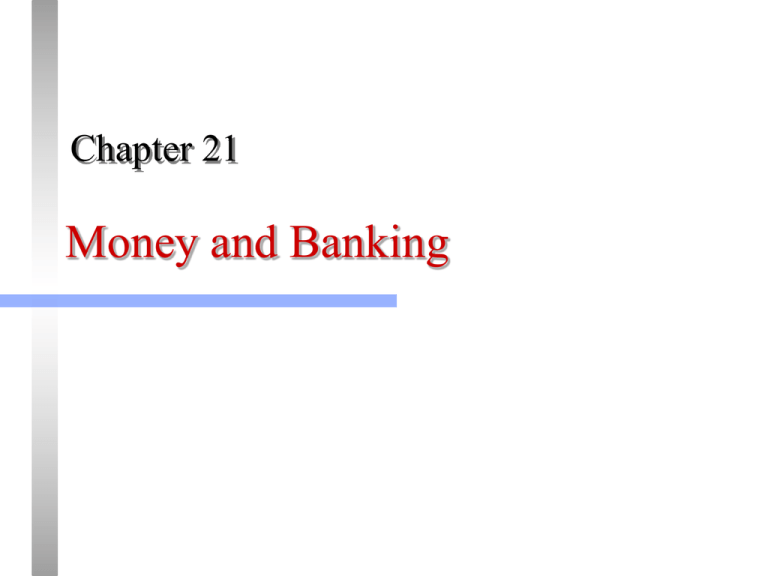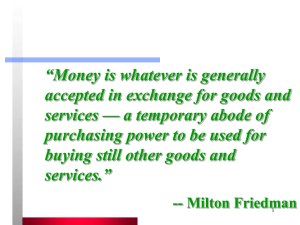
Chapter 21
Money and Banking
“Money is whatever is generally accepted in
exchange for goods and services—accepted
not as an object to be consumed but as an
object that represents a temporary abode of
purchasing power to be used for buying still
other goods and services.”
-- Milton Friedman
2
Copyright © Houghton Mifflin Company. All rights reserved.
What is Money?
Money is anything that is generally
acceptable to sellers in exchange for
goods and services.
A liquid asset is an asset that can
easily (i.e., quickly, cheaply,
conveniently) be exchanged for
goods and services.
3
Copyright © Houghton Mifflin Company. All rights reserved.
What is Money?
Functions of Money
1) Medium of exchange
2) Unit of account
3) Store of value
4) Standard of Deferred Payment
4
Copyright © Houghton Mifflin Company. All rights reserved.
Medium of Exchange (1)
The use of money as a medium of
exchange lowers transactions costs.
Trade without money, directly exchanging
goods for goods, is called barter.
–
–
Barter requires a double coincidence of
wants—each party to the exchange has to
want what the other has to trade.
Finding someone else who wants what you
have to trade and who has what you want is
time-consuming and costly.
5
Copyright © Houghton Mifflin Company. All rights reserved.
Medium of Exchange (2)
A medium of exchange must be:
–
–
–
Widely accepted for payment
Portable: easy to transport and transfer
to the seller
Divisible: measurable in both small and
large units
6
Copyright © Houghton Mifflin Company. All rights reserved.
Unit of Account
Money acts as a common unit of
measurement.
This allows us to compare the values
of very dissimilar things.
It makes accounting possible.
As a result of these things, it lowers
information costs.
7
Copyright © Houghton Mifflin Company. All rights reserved.
Store of Value
Money makes it possible to carry buying power
forward into the future.
Therefore, for money to be a store of value, it
must be durable.
–
–
–
Durability is the ability to retain value over time.
Inflation can reduce the effectiveness of money as a
store of value.
This can lead to currency substitution—the use of
foreign money as a substitute for domestic money when
the domestic economy has a high rate of inflation.
8
Standard of Deferred Payment
Debt is denominated in money terms.
The standard for repayment is money.
There is a difference between money and
credit:
–
–
–
Money is what you use to pay for goods and
services.
Credit is available savings that are lent to
borrowers to spend.
Credit is debt, something you owe.
9
M1 Money Supply
Money in the United States Today
consists of:
–
–
Currency is the bills and coins that we
use.
Deposits are also money because they
can be converted into currency and are
used to settle debts.
10
What is Money?—M1
M1 is the narrowest and most liquid measure of
the money supply.
–
M1 includes:
–
–
–
–
It includes financial assets that are immediately
available for spending on goods and services.
Currency
Travelers’ Checks
Demand Deposits (checking accounts)
Other Checkable Deposits (interest-bearing checking)
Demand Deposits and Checkable Deposits are
called transactions accounts—these are checking
accounts that can be drawn upon to make
payments.
11
U.S. Money Supply: M1
12
About Currency
In 2003, currency was 52% of M1.
U.S. currency today is not backed by
gold or silver.
–
–
–
It is backed only by the confidence and
trust of the public.
It is a fiduciary monetary system.
(“Fiducia” means “trust” in Latin.)
Also called “fiat money”
13
About Currency
Money backed by gold or silver (or
something else of value) is called
commodity money.
–
the commodity itself may be used as
money
•
Gold, silver, shells, beads, chocolate,
cigarettes, diamonds, etc.
14
Problems with Commodity Money
At times, the precious metal in gold or
silver coins may be worth more than the
face value of the coins.
–
–
In such situations, the public will begin to
hoard the coins.
According to Gresham’s Law, if two coins have
the same face value but different intrinsic
(commodity) values, the cheaper coin will be
used to make transactions and the other coin
will be hoarded. “Bad money drives out good.”
15
What is Money?—M2
M2 adds to M1 less liquid assets that
can be converted to M1 assets
quickly and at low cost.
Includes everything in M1
Adds:
–
–
–
Savings deposits
Small denomination time deposits (CDs)
Retail money market mutual funds
16
U.S. Money Supply: M2
17
The Equation of Exchange
M = money stock (M1 or M2)
V = velocity of circulation of
money (how many times per
year each unit of the money
stock is used to purchase
final goods)
P = price level (e.g., consumer
price index)
Q = real GDP
MV = PQ
U.S. Money Supply: M3
19
Financial Intermediaries
Four Types of Financial Intermediaries
1) Commercial banks
2) Savings and loan associations
3) Savings banks and credit unions
4) Money market mutual funds
20
Financial Intermediaries
Commercial Banks
–
–
Financial institutions that offer deposits on which
checks can be written. They make loans to households
and businesses. They are corporations.
Originally only commercial banks could offer (noninterest-bearing) checking accounts.
Thrift Institutions
–
–
–
–
Savings and Loan Associations, Credit Unions, Mutual
Savings Banks.
Created to encourage saving, hence “thrift”.
Until 1980, these institutions could offer higher interest
rates on savings accounts than banks.
Now “thrifts” can offer many of the same services as
commercial banks.
21
Deposit Insurance
A bank panic occurs when depositors,
fearing a bank’s closing, rush to withdraw
their funds.
To reduce the likelihood of bank panics, in
1933 the Federal Deposit Insurance
Corporation (FDIC) was created.
–
This is a federal agency that insures bank
deposits so that depositors do not lose their
deposits if a bank fails.
22
Bank Failures
23
International Banking (1)
Eurocurrency market or “offshore
banking”: the market for deposits and
loans generally denominated in a currency
other than the currency of the country in
which the transaction occurs.
–
–
–
For example, a U.S. firm may borrow U.S.
dollars from a bank in London.
Because foreign banks do not operate under
U.S. legal restrictions, they may offer better
interest rates on deposits and loans.
On the other hand, foreign banking laws do
apply and may cause other problems.
24
International Banking (2)
International Banking Facilities (IBFs)
were legalized by the Federal Reserve
Board in December 1981.
An IBF is a division of a U.S. bank that is
allowed to receive deposits from and
make loans to nonresidents of the U.S.
without the restrictions that apply to
domestic U.S. banks.
This allows domestic banks to compete
more fairly with offshore banks.
25
Informal Markets
in Developing Countries
ROSCAs—Rotating Savings and
Credit Associations
–
–
Operate like savings clubs
Example: 12 members contribute every
month, and then every 12th month each
member receives the full amount
contributed by everyone.
26
Fractional Reserve Banking
A system in which banks keep less
than 100 percent of the deposits
available for withdrawal.
–
Regulated by Federal Reserve Board
27
How Banks Create Money
Reserves: Actual and Required
–
–
–
The reserve ratio is the fraction of a bank’s
total deposits that are held in reserves.
The required reserves ratio is the ratio of
reserves to deposits that banks are required,
by regulation, to hold. Required reserves are
those reserves which must be kept on hand or
on deposit with the Federal Reserve in order to
comply with the reserve requirements.
Excess reserves are the cash reserves beyond
those required, which can be loaned.
28
How Banks Create Money
29
How Banks Create Money
30
How Banks
Create
Money
31
How Banks Create Money
Deposit Expansion Multiplier =
1
Reserve Requirement (ratio)
NOTE: Cash leakage or excess reserves held in
banks will reduce the multiplier effect
32
The Multiple Creation of Bank Deposits
33
Required Reserve Ratio
From the Federal Reserve web site (5/1/07)
Liability Type
RRR in %
Transaction accounts
$8.5 million
0%
$8.5 to $45.8 million
3%
$45.8 million +
10%
Non-personal time deposits
0%
Eurocurrency liabilities
0%
34
Instruments of Monetary Policy
Open market operations are purchases and sales of government
securities by the Fed. They are the most frequently used
instrument of monetary policy.
Changes in interest rates
–
–
Discount rate charged by the Fed on reserves it loans to commercial
banks
Deposit rate paid by the Fed on reserve deposits of commercial banks
Changes in required reserve ratios can also be used to affect the
money supply. The Fed does not use this instrument of monetary
policy, but it is used by some other central banks around the
world.
Purchases and sales of foreign assets are used by many central
banks as an instrument of monetary policy, but not by the Fed in
recent years.
Dolan, Economics Combined Version 4e, Ch.
21







